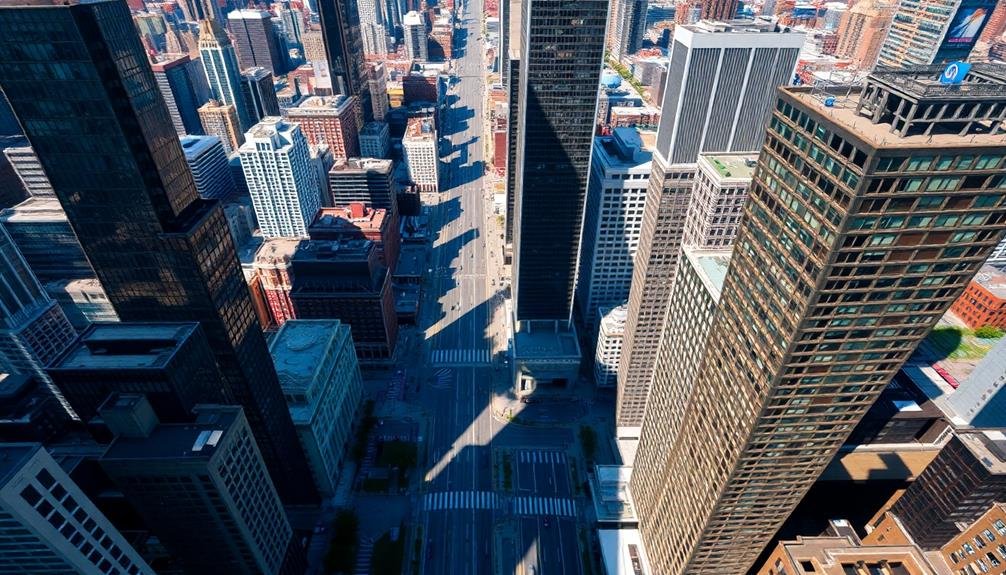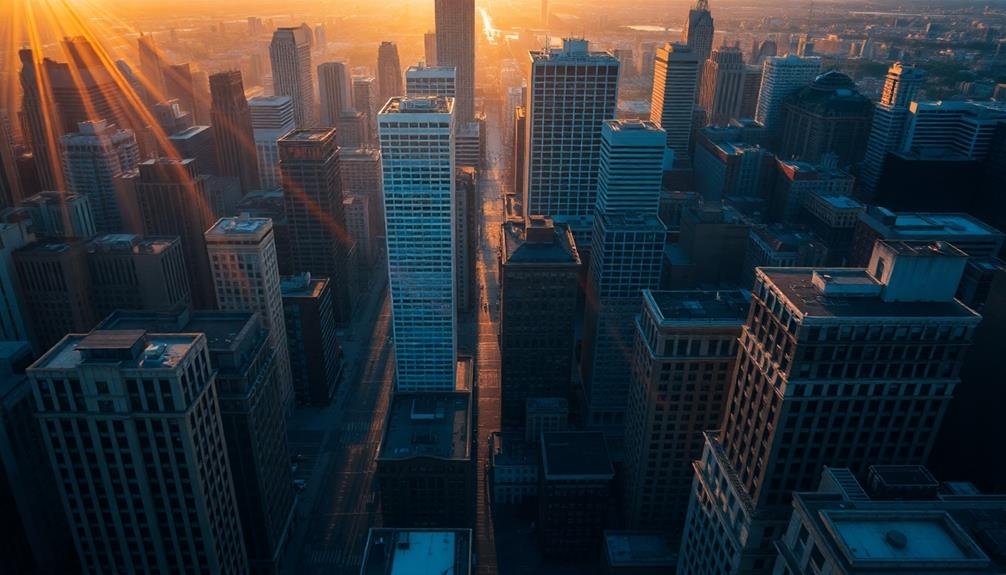Unique perspectives in aerial photography matter because they transform ordinary scenes into extraordinary visual narratives. By embracing unusual angles, you'll reveal hidden patterns and textures that aren't visible from the ground. Capturing scale and perspective helps viewers understand the grandeur of landscapes, while playing with shadows and light adds depth and drama to your shots. Framing with natural elements enhances composition and guides the viewer's eye. These techniques encourage deeper engagement with your images, elevating them from common to enchanting. As you explore the sky-high domain of aerial imagery, you'll open up a world of creative possibilities that will set your work apart.
Key Takeaways
- Unique angles reveal hidden patterns and textures in landscapes, offering viewers fresh insights into familiar scenes.
- Unusual perspectives challenge viewer expectations, encouraging deeper engagement and appreciation of aerial imagery.
- Creative framing with natural elements adds depth and context, guiding the viewer's eye and enhancing visual storytelling.
- Varied altitudes and orientations transform ordinary subjects into abstract compositions, sparking curiosity and interest.
- Distinctive vantage points capture scale and perspective in compelling ways, providing emotional impact and contextual understanding.
Embracing Unusual Angles

Three key elements define unusual angles in aerial photography: perspective, altitude, and orientation. When you're capturing sky-high imagery, embracing these elements can transform your shots from ordinary to extraordinary.
Perspective involves choosing unexpected vantage points, like shooting directly downward or at sharp diagonals. This approach reveals patterns and textures that aren't visible from the ground.
Altitude plays an essential role in creating unique angles. You'll find that varying your height can dramatically alter the composition of your images. Low-altitude shots might emphasize details and create a sense of intimacy, while high-altitude captures can showcase vast landscapes and intricate urban layouts.
Orientation is about rotating your camera to challenge viewers' expectations. Try tilting your frame or even flipping it completely upside down. This technique can disorient viewers in an engaging way, encouraging them to engage more deeply with your images.
Patterns and Textures From Above

Building on the concept of unusual angles, let's explore the enchanting world of patterns and textures visible from above. When you're capturing aerial imagery, you'll discover a whole new dimension of visual interest that's often hidden from ground level.
From the sky, you'll notice how natural landscapes form intricate patterns. River deltas branch out like veins, while sand dunes create rippling textures across deserts. Forests reveal a patchwork of different shades and textures, especially during seasonal changes.
Even agricultural fields become geometric puzzles of various colors and shapes.
In urban settings, you'll find equally engaging patterns. City grids form precise geometric designs, while skyscrapers create a textured skyline. Parking lots, stadiums, and industrial areas offer unexpected visual treats when viewed from above.
To capture these patterns effectively, you'll need to reflect on lighting conditions. Early morning or late afternoon sun can enhance shadows and textures, making patterns more pronounced.
Don't forget to experiment with altitude – different heights can dramatically alter the perception of patterns and textures in your aerial imagery.
Capturing Scale and Perspective

Aerial photography's unique vantage point offers an unparalleled opportunity to showcase scale and perspective in your images. From high above, you'll capture the true magnitude of landscapes, cityscapes, and natural phenomena that are often impossible to convey from ground level.
To effectively capture scale, include recognizable objects in your frame. A lone car on a winding mountain road or boats dotting a vast ocean can instantly communicate the immensity of the scene. Experiment with altitude to find the sweet spot that best illustrates the relationship between elements in your composition.
Perspective in aerial photography isn't just about height; it's about angle too. Try shooting straight down for a fascinating top-down view, or capture oblique angles to show depth and dimension. You can create striking visual contrasts by juxtaposing large and small elements within the same frame.
Don't forget to take into account lighting when capturing scale and perspective. Long shadows cast by early morning or late afternoon sun can emphasize textures and add depth to your images, further enhancing the sense of scale and dimension in your aerial shots.
Shadows and Light Play

Shadows and light play an essential role in creating depth and drama within aerial photography. As you capture images from above, you'll notice how the interplay of light and shadow can transform landscapes and cityscapes alike. The angle of the sun, time of day, and weather conditions all contribute to the unique patterns and contrasts you'll see from your aerial vantage point.
When shooting from above, you'll want to pay close attention to how shadows stretch across the terrain, creating interesting shapes and textures. Long shadows cast by buildings or natural formations can add a sense of scale and dimension to your images.
You'll also find that the golden hours – just after sunrise and before sunset – offer particularly dramatic lighting conditions for aerial photography.
To evoke emotion in your audience through shadows and light play, consider these techniques:
- Capture the stark contrast between sunlit areas and deep shadows
- Use backlighting to create silhouettes and mysterious atmospheres
- Highlight the interplay of light on reflective surfaces like water or glass
- Showcase the change of light across landscapes during different times of day
Framing With Natural Elements

While shadows and light create drama, natural elements can provide stunning frames for your aerial compositions. When you're capturing sky-high imagery, look for opportunities to use trees, mountains, or bodies of water as natural frames. These elements can add depth and context to your shots, drawing the viewer's eye to the main subject.
You'll want to experiment with different angles and altitudes to find the perfect framing. Try positioning your drone so that a row of trees creates a natural border along the bottom of your image, or use a mountain range to frame a valley below. Water features like rivers or coastlines can serve as leading lines, guiding the viewer's gaze through your composition.
Don't forget to reflect on the season and time of day when planning your shots. Autumn foliage can create vibrant frames, while winter snow adds a stark contrast. Early morning or late afternoon light can enhance the texture and dimensionality of your natural frames.
Frequently Asked Questions
What Equipment Is Essential for Capturing High-Quality Aerial Imagery?
You'll need a high-resolution camera, preferably with interchangeable lenses. Don't forget a reliable drone or aircraft, stabilization equipment, and extra batteries. GPS and mapping software are essential for precise location tracking and image georeferencing.
How Do Weather Conditions Affect Sky-High Photography?
Weather conditions greatly impact your sky-high photography. You'll face challenges with lighting, visibility, and camera stability. Wind can affect your drone's flight, while clouds and precipitation may obscure your subject or create unique atmospheric effects.
Are There Legal Restrictions for Drone Photography in Different Locations?
You'll find legal restrictions for drone photography vary widely by location. Check local laws before flying. In many areas, you'll need permits, can't fly over people, and must follow altitude limits and no-fly zones.
What Post-Processing Techniques Enhance Aerial Images?
You'll enhance your aerial images with techniques like color correction, exposure balancing, and sharpening. Don't forget to adjust contrast, remove haze, and experiment with HDR. Cropping can also improve composition and focus in your shots.
How Can Photographers Ensure Safety When Capturing Sky-High Imagery?
You'll need to prioritize safety when capturing sky-high imagery. Always follow aviation regulations, use reliable equipment, check weather conditions, and wear protective gear. Don't forget to secure your camera and maintain situational awareness throughout the shoot.
In Summary
You've explored the power of unique perspectives in aerial photography. By embracing unusual angles, finding patterns, and playing with scale, you've opened up a new way of seeing the world. Don't forget to experiment with shadows and use natural elements to frame your shots. Remember, your distinct viewpoint is what sets your sky-high imagery apart. Keep pushing boundaries and you'll continue to create breathtaking aerial photos that captivate viewers and tell compelling stories.

As educators and advocates for responsible drone use, we’re committed to sharing our knowledge and expertise with aspiring aerial photographers.




Leave a Reply